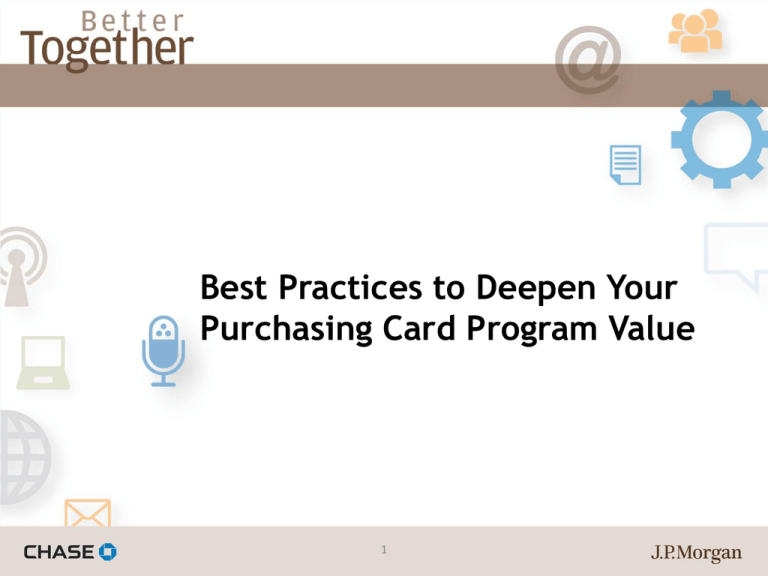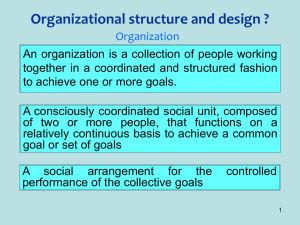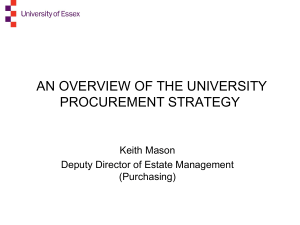
Best Practices to Deepen Your
Purchasing Card Program Value
1
This presentation was prepared exclusively for the benefit and internal use of the J.P. Morgan Chase client to whom it is delivered (including such
client’s subsidiaries, the “Company”) in order to assist the Company in evaluating, on a preliminary basis, certain products or services that may be
provided by J.P. Morgan Chase. This presentation contains information which is confidential and proprietary to J.P. Morgan Chase, which may only
be used in order to evaluate the products and services described herein and may not be disclosed to any other person. In preparing this
presentation, we have relied upon and assumed, without independent verification, the accuracy and completeness of all information available from
public sources or which was provided to us or which was otherwise reviewed by us.
This presentation is for discussion purposes only and is incomplete without reference to, and should be viewed solely in conjunction with, the oral
briefing provided by J.P. Morgan Chase. Neither this presentation nor any of its contents may be used for any other purpose without the prior
written consent of J.P. Morgan Chase. J.P. Morgan Chase makes no representations as to the legal, regulatory, tax or accounting implications of the
matters referred to in this presentation.
Notwithstanding anything in this presentation to the contrary, the statements in this presentation are not intended to be legally binding. Any
products, services, terms or other matters described in this presentation (other than in respect of confidentiality) are subject to the terms of
separate legally binding documentation and/or are subject to change without notice.
Neither J.P. Morgan Chase, nor any of its directors, officers, employees or agents shall incur any responsibility or liability whatsoever to the
Company or any other party in respect of the contents of this presentation or any matters referred to in, or discussed as a result of, this document.
J.P. Morgan Chase is a marketing name for certain businesses of JPMorgan Chase Bank & Co. and its subsidiaries worldwide.
© 2013 JPMorgan Chase & Co. All rights reserved
2
Discussion Agenda
Review purchasing expense management process
Discuss best practices for each step of the process
Identify opportunities for new or established programs
3
Purchasing Card Best Practices
4
Purchasing Management Process
Purchasing
Process
Source
Policy
Payment
Reconcile
Report
Multiple Stakeholders & Processes – Purchasing, AP, Finance, HR, IT
Program
Drivers
Organization Culture – targeted/generic, controlled or flexible
Organizational Complexity – industry, organizational footprint
5
Source
Policy
Payment
6
Reconcile
Report
Poll
When did you last conduct an accounts payables analysis to evaluate
current purchasing card coverage of your organizations spend?
Within the last year
Within the last two years
Within the last three years
We have never done an accounts payable analysis
Do not know
7
Sourcing
Conduct an annual accounts payable analysis to identify the potential
purchasing card (P-Card) Vendors
Understand current P-Card penetration of Vendor base
Understand Vendor payment terms for prospective P-Card Vendors
Review Vendor payment strategy to validate alignment with
organizational goals and controls
Update specific categories of spend for purchasing card payment
Ensure alignment with financial policies and procurement procedures
Develop Vendor contract language that requires card payment for future
negotiations
Clarify or revalidate Vendor value for accepting P-Card
Leverage purchasing card spend reporting for Vendor consolidation opportunities
8
Source
Policy
Payment
9
Reconcile
Report
Poll
How often do you review and update your procurement policy to align to
your purchasing card program?
As needed
Every year
Every two years
We have never updated our purchasing card policy
Current policy does not include purchasing card
10
Policy
Review current policies and procedures for purchasing card use
Specify Vendors or categories of spend where card can be used
Ensure appropriate level of controls for card types that enable use
Communicate and ensure the policy is accessible
Develop creative ways to raise awareness of the policy
Post policy on company intranet site and incorporate into training for targeted
users
Drive continuous improvement in your policy
Conduct formal policy review every one or two years
Ensure the ability to incorporate “just in time” changes to policy as needs evolve
11
Source
Policy
Payment
12
Reconcile
Report
Poll
How are your purchasing cards most often used?
Issued to an individual employee
Issued to a department for shared use
Issued for targeted Vendors
Issued within accounts payable for invoice processing and payment
Embedded within e-procurement or e-commerce tools
13
Payment
Review and update purchasing card user profiles
Monitor card usage and distribution to ensure use for individual and department spend
Review AP use cases for general invoice payments or targeted Vendors
Set appropriate spend limits and controls per user profile
Ensure limits and controls align with scope of authority
Review and adjust limits on a regular basis
Establish processes with Vendors to capture appropriate level of data
Determine where enhanced level of detail is required
Ensure enhanced detail is being captured
14
Source
Policy
Payment
15
Reconcile
Report
Poll
What percentage of your transactions are reconciled by your cardholders
and program administrators prior to cycle close and payment to J.P.
Morgan?
20% or less
20% - 50%
50% - 80%
80% - 99%
100%
16
Reconciling
Ensure that all transactions are reconciled
Utilize tools to assign accounting codes to transactions
Develop a disciplined process to ensure review and approval of transactions prior to
payment
Determine and review ongoing audit strategy
Review and modify risk tolerance based on organizational policy.
Review and modify audit process that ensures accountability without loss of
efficiency
Integrate purchasing card data into your accounting system
Review integration process for potential improvements or efficiencies
Review and update processes to manage data integration
17
Source
Policy
Payment
18
Reconcile
Report
Poll
How often do you conduct a review of your program and review the
results with key stakeholders?
Every month
Every quarter
Every year
Review program but do not communicate with stakeholders
Do not review program
19
Reporting
Review key performance indicators to track program performance
Measure program performance against established success metrics
Review reporting usage to assess value and impact
Establish an annual process to review performance and update goals
Modify controls or payment strategy based on performance
Update program controls and categories of spend based on identified opportunity
Review current reporting strategy and key stakeholders
Understand opportunities to leverage PCard program data within the organization Sourcing, Finance, HR
Provide quarterly or monthly data and conduct review
20
Higher Ed Benchmarking Analysis
21
Higher Education Commercial Card Overview
Commercial Card MCC Spending1
DENTAL/LAB/MED EQUIPMENT
7%
7%
OTHER DIRECT MARKETERS
22%
BUSINESS SERVICES
7%
COMPUTERS/SOFTWARE
7%
12%
8%
CATALOG MERCHANT
BOOK STORES
SCHOOLS
11%
8%
11%
INDUSTRIAL SUPPLIES
STATIONERY/OFFICE SUPPLIES
STATIONERY STORES
Commercial Card Metrics
Higher Ed
Metric
All Industries
% Transactions Under $2,500 on a
Purchasing Card2
Large Institutions: 55%
% Transactions $2,500 – $10,000
on a Purchasing Card2
Large Institutions: 31%
Small: 20%
28%
Average Purchasing Card
Transaction Amount2
$267
$348
Average Corporate Card
Transaction Amount3
$298
$227
Travel Spending by Payment
Mechanism3
68%
85%
Corporate Card
44%
Small: 47%
Global Commercial Card Best Practices Opportunities & Benefits
Benefits
Best Practice
Achieve Active Senior
Management Support of
Card Program
Integrate Commercial
Card Program into the
Green Initiative
Align with corporate goals, demonstrate value
Increase visibility of program across the company
Reduce paper and fuel usage
Align with corporate goals, demonstrate value
Highlight commitment to customers
Investigate Expansion of Increase spending under management in nontraditional spend categories
Commercial Card into
New Spend Categories
Enhance automation with elimination of POs
Best Practice
Benefits
Integrate Commercial
Card with eProcurement
Technology
Increase liquidity, reduce use of cash reserves
Streamline and automate the procurement process
from purchase order to payment
Develop
Comprehensive
Commercial Card
Training Program
Communicate updates, reduce misperceptions
Enhance program visibility
Increase spending compliance
Optimize Use of Ghost
Cards or Virtual Accounts
for Procurement Spend
Streamline ordering process, increase efficiency
Allow staff to focus on value-added activities
Increase spending under management
Visa PerformSource Source:
(1) Commercial Card Spending MCC metrics for this report were derived from aggregated Visa commercial card spend from a subset of Visa purchasing card transactions by US organizations between January 1, 2010 and
December 31, 2010 and represent the top 10 MCCs by spend and the % of spend out of the total aggregated spend within the top 10 MCCs.
(2) RPMG Research 2010 Purchasing Card Benchmarking Survey; (2) RPMG Research 2011 Corporate Card Benchmark Survey.
Higher Education Procure-to-Pay Overview
Procurement Tools within Higher Education1
Procure-to-Pay Maturity Model
Establish an End to End
Automation Strategy
Consolidate
Spend Data, Conduct
Spend Analysis
Optimize Program
Performance
Foundational
Advanced
Institute a Supplier
Management Program
Benchmark
Procure-to-Pay Process
Establish Supplier KPIs
Global Higher Education Sector
Global Procure-to-Pay Best Practices Opportunities & Benefits
Benefits
Best Practice
Develop a Procure-toPay End-to-End
Automation Strategy
Evaluate Accounts
Payable Automation
Solutions
Consolidate Spend Data
and Conduct Spend
Analysis
Improve working capital management
Reduce time and expense
Free staff time for more strategic activities
Reduce paper in the payment cycle
Implement a solution appropriate to specific
company needs
Gain visibility into indirect spending
Eliminate redundant spending
Track and prevent non-compliant spending
Best Practice
Automate Order
Placement with an eProcurement Solution
Institute a Supplier
Management Program
Automate the Payment
Approval Process
Benefits
Increase spending under management
Reduce time, expense and errors
Decrease redundant spending
Align suppliers with procurement strategy and policies
Establish preferred supplier relationships and improve
pricing negotiations
Ensure supplier compliance with negotiated contract
terms
Allow staff to focus on value-added activities
Visa PerformSource Source:
(1) Public College & University Procurement,” American Association of State Colleges and Universities (AASCU) National Association of Education Procurement (NAEP) 2010.
Chip and Pin
24
Chip and Pin
• JPM is actively developing a U.S. chip card solution
• JPM’s chip solution will fully integrate into our existing U.S. programs without compromise.
Environment Today
J.P. Morgan Chip Strategy
front
Magnetic stripe cards continue to be the primary card-type
back
Project is in active status and moving forward as planned.
accepted within the U.S.; however, chip card acceptance is
rapidly growing internationally.
J.P. Morgan is working to provide U.S. Clients with access to
chip based commercial cards.
While magnetic stripe cards still work at a majority of
international merchants, chip-only acceptance is growing at:
The comprehensive approach includes:
- Ability to issue chip cards into an existing or new program.
- Unmanned ticket kiosks
- Efficiently integrates into existing program structure.
- Gas stations
- Commercial cards that will include both a chip and a
magnetic stripe.
As a result, U.S. Cardholders, traveling internationally may
need to:
- Be persistent in asking a merchant to swipe their card
- Plan ahead to purchase train tickets
- Use cash for select transactions
- Enabling existing cards to be converted to chip cards and
retain existing account numbers
- Availability on both MasterCard and/or Visa.
Cardholders will be able to efficiently set / re-set their 4-digit
PIN within our Customer Service automated line.
■ U.S. banks and card issuers remain in the early stages of
introducing chip cards for their customers.
At this time we are in Pilot and expect to roll out chip cards to
select clients in late 2014 and early 2015.
25
Questions for Panelists or JPM?
26










